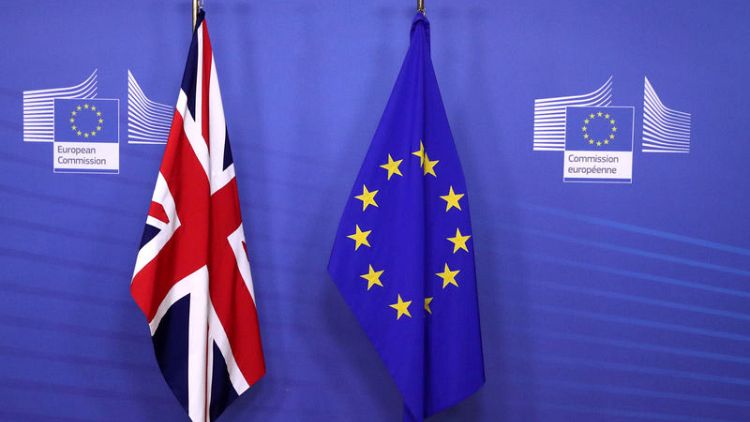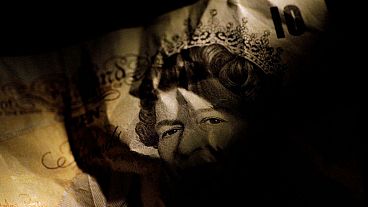By Tommy Wilkes and Dhara Ranasinghe
LONDON (Reuters) - There's nothing like a market crash to focus the minds of politicians, and Prime Minister Theresa May could find that only a plunge in British asset prices can persuade a divided parliament to back her Brexit deal.
But how much do investors reckon sterling and stocks would have to tank before lawmakers decide that a "no deal" exit from the European Union must be averted?
Expectations that parliament will reject the withdrawal agreement May has negotiated with the EU have prompted investors to start buying protection against a sterling plunge, and implied market volatility measures are up.
So far, however, there is no sign of the kind of financial market carnage that might swing both pro- and anti-Brexit MPs behind May's deal for fear that Britain could blunder out of the bloc on March 29 with no transition arrangements in place.
That suggests investors still see some form of negotiated exit as the most likely outcome.
The Bank of England has warned that a "no deal" scenario would be an economic shock akin to the 1970s oil crisis.
"In what could concentrate the minds of politicians, you would need to see a significant fall (in asset prices) -- more than we saw last week," said Robin Marshall, a director for fixed income at investment firm Smith & Williamson.
He estimated a swift move of between 5 and 7 percent in sterling and the stock market would prompt a reaction.
Parliament is likely to vote on May's deal in mid-December. If cross-party opposition defeats her plans, the risk becomes real that Brexit will become "no deal" by default.
That could spark what former government advisor Rupert Harrison, now a portfolio manager at BlackRock, has dubbed the "TARP" model: the resulting market crash would see lawmakers quickly abandon opposition to May's deal and approve it at the second attempt with minor changes.
For a graphic on Market muscle and TARP, see - https://tmsnrt.rs/2R5Djd8
TARP is a reference to the Troubled Asset Relief Program, a U.S. government initiative to bail out banks at the height of the 2008 financial crisis. Rejection of TARP by the House of Representatives on Sept. 29 triggered an almost 10 percent fall on Wall Street. The House backtracked four days later.
Other such parallels abound. Greek Prime Minister Alexis Tsipras, elected in 2015 to reverse EU-imposed austerity, rowed back on campaign promises as tumbling markets endangered Greek banks.
In May, the biggest Italian bond selloff in 25 years forced two bickering political parties to the table to form a coalition government, with politicians scrambling to reaffirm Rome's commitment to the euro.
For a graphic on Market muscle and Italy, see - https://tmsnrt.rs/2R3YbBn
"NOT SHOCKING ENOUGH"
Closer to home, there was "Black Wednesday", the day in 1992 when Britain was ejected from the European Exchange Rate Mechanism (ERM) -- a precursor to the euro -- after it could no longer defend the pound against speculative attacks. The crisis forced authorities into a brutal cycle of interest rate hikes.
"Hard" Brexit could cause similar economic disaster. UBS calculates Britain would lose 10 percent of output, faring only slightly better with a "soft" deal, at 6 percent.
But it will be sterling that will take centre-stage if the TARP model is to rescue May -- her game-plan according to some, although others view it as wishful thinking. They argue that market swings already seen since the June 2016 referendum have done little to change lawmakers' views about Brexit and what form it should take.
"My view is sterling has to come under more pressure to become party to the chaos," said Salman Ahmed, chief investment strategist at Lombard Odier.
Ahmed reckons that in a no-deal Brexit scenario the pound would slide another 10-12 percent. That would leave sterling near $1.13, its lowest in more than 30 years.
"In Greece for example, the pain in the market especially in the banking sector helped contribute to the compromise by Alexis Tsipras. I don't see that happening just yet in the UK because it's not been shocking enough," he said.
Observers note recent sterling moves have been limited, despite appearing dramatic. When the EU rejected May's Chequers proposals for post-Brexit ties on Sept. 21, sterling dropped 1.7 percent. It slid another 2 percent on Nov. 15 when ministers quit over May's newly-inked deal.
That compares with a 7.8 percent drop against the dollar on June 24, 2016, the day after the Brexit referendum.
Growing expectations that parliament will reject May's deal could themselves undermine the TARP scenario if a first-time failure for the bill is priced into markets.
For a graphic on Recent sterling falls small against Brexit vote aftermath, see - https://tmsnrt.rs/2R5kMhb
Relatively contained moves so far reflect the belief among investors that a smooth exit or even a second referendum are more likely than a messy no-deal. That's made them wary of selling sterling outright, fearing a huge rebound in the undervalued currency if an exit deal is reached.
They have resorted instead to derivatives rather than spot foreign exchange markets to take positions.
There are signs that if things start getting really painful, other asset classes will feel it too.
Last week, when it appeared that ministers were mobilising to unseat May, the FTSE's inverse correlation with sterling vanished -- a rare occurrence of the currency and British stocks falling in tandem.
It also offered a glimpse of the broader economic chaos. Property shares fell sharply, raising fears the housing market, the store of most Britons' wealth, would take a hit. Bank shares tumbled too, rekindling memories of Northern Rock's collapse in 2007.
For a graphic on Correlations FTSE sterling Nov 22, see - https://tmsnrt.rs/2R3YgoF
"KINDNESS OF STRANGERS"
Most investors are reluctant to pick a particular level that would persuade politicians to agree a deal. But a rush in option markets to protect against further sterling slides shows nervousness is growing.
BNY Mellon strategist Simon Derrick expects action when headlines of market mayhem spread worldwide at a time when liquidity is thin as the end-of-year holidays approach.
"It's when the volatility starts to spill over into international markets," he said, pointing to the December-January period when, after a failed first attempt to get it through parliament, the government would have a short window to try again.
A rout in the pound presents risks because the UK's large current account deficit makes it -- in Bank of England Governor Mark Carney's words -- reliant on the "kindness of strangers" or overseas investment to pay its bills.
Sterling's devaluation since the 2016 referendum has shrunk the deficit but it still stands at 3.9 percent of GDP.
Ben Lord, a UK fund manager at M&G Investments, noted this was similar to levels seen during the ERM crisis or Britain's 1976 bailout by the International Monetary Fund.
"We don't want a catalyst where we see those strangers, those foreign sources of money stop funding us. That's when we get a very sharp sterling devaluation."
(Additional reporting by Sujata Rao, Saikat Chatterjee and Abhinav Ramnarayan; Graphics by Ritvik Carvalho; Writing by Tommy Wilkes; Editing by Catherine Evans)



